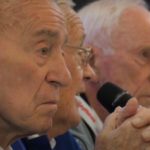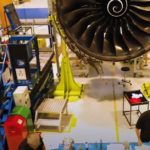Ampaire has accomplished the longest flight to date for a commercial aircraft using electric propulsion.
Ampaire’s Electric EEL, a six-seat Cessna 337 twin-engine aircraft modified with an electric motor in the nose and traditional combustion engine in the rear, made the 341 mile flight from the outskirts of LA to the San Franciso Bay area on Monday. Test pilot Justin Gillen and Flight Test Engineer Russell Newman, flew up California’s Central Valley at 8,500 feet, landing at Hayward Executive Airport. Their speed during the cruise portion of the two hour, 32-minute flight averaged around 135 mph.
Gillen said: “The mission was a quite normal cross-country flight that we could imagine electrified aircraft making every day just a few years from now.”
The milestone electric flight took place after four weeks of flight testing in the Camarillo area for the second Electric EEL test aircraft, which first flew on September 10. During the period, the aircraft flew more than 30 hours during 23 flights, in 28 days, achieving 100 per cent dispatch reliability.
Goal to introduce low-emissions aircraft to regional and charter airlines in years
Ampaire General Manager Doug Shane added: “Our success in taking this aircraft in a short period from the test environment to the normal, everyday operating environment is a testament to our development and test organization, and to the systems maturity we have achieved with our second aircraft.”
“The ability to put innovative electric technologies into the air rapidly in order to assess and refine them,” he added, “is central to Ampaire’s strategy to introduce low-emissions aircraft for regional airlines and charter operators within just a few years.”
The EEL flown to Hayward is dubbed the Hawaii Bird, as it will take part later this year in a series of demonstration flights with Hawaii-based Mokulele Airlines on its short-haul routes. The flight trials with Mokulele will demonstrate the capabilities of the EEL and define the infrastructure required for the wide adoption of electric aviation by airlines and airports. These flight demonstrations will mark the first time an electrically-powered aircraft has flown under an FAA “Market Survey” experimental aircraft certificate in order to gain real world flight experience.
Emissions savings of up to 50 per cent on shorter routes
The aircraft will be partially disassembled at Hayward Executive Airport for shipment to Hawaii. The flight trials in Hawaii are funded in part by Elemental Excelerator, a global climate-tech accelerator based in Honolulu. The Electric EEL can generate fuel and emissions savings of up to 50 per cent on shorter regional routes where the aircraft’s electrical propulsion unit can be run at high power settings, and generate savings of about 30 per cent on longer regional routes such as the Camarillo to Hayward flight.
Ampaire CEO Kevin Noertker said: “The Electric EEL is our first step in pioneering new electric aircraft design. Our next step will likely be a 19-seat hybrid electric retrofit programme that will lower emissions and operating costs, benefiting regional carriers, their passengers and their communities.”
Ampaire, which has received funding from NASA and others, is in the midst of design studies for such an aircraft based on the popular de Havilland Twin Otter aircraft. Ampaire has named the hybrid-electric 19-seater aircraft the Eco Otter SX.

